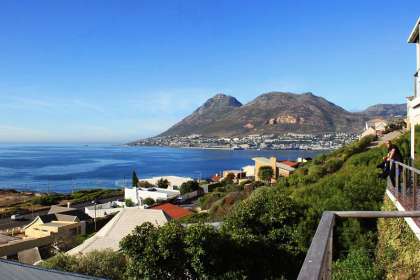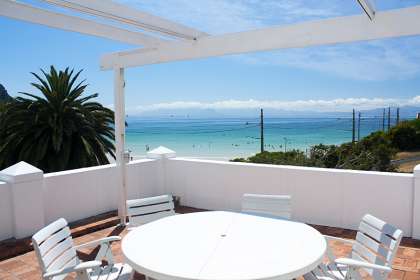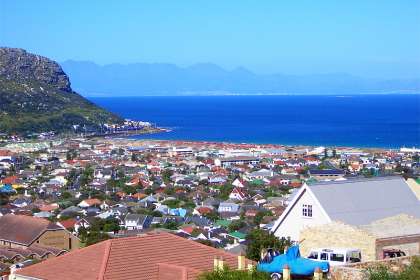Cape Point Nature Reserve - Cape of Good Hope
Cape Point Nature Reserve - Cape of Good Hope
When Bartolomeu Dias first sailed past the Cape in 1488 - no doubt cursing through his teeth - he named the area the Cape of Storms. The gale force winds that frequently blow across the peninsula were also the inspiration for the legend of the Flying Dutchman. But it was later renamed the Cape of Good Hope, as it represented a gateway to the trade routes of the East.
The lighthouse at Cape Point is a mandatory stop for any bus tour that circumnavigates the Cape Peninsula. But if you have more time, you may wish to explore the beaches and tidal pools that can be found along it's rocky shoreline. Venus Pool on the False Bay side is a pleasant location for swimming or fishing. Anglers may obtain fishing permits at the gates.
The Buffelsfontein Visitor Centre has audiovisual presentations and interesting artefacts that shed light upon the Cape's cultural and natural history.
The Cape Point Nature Reserve has now been incorporated into the much larger Table Mountain National Park, which has been proclaimed by UNESCO as a Natural World Heritage Site.
Five interesting facts about the Cape of Good Hope:
1. Historical Significance: The Cape of Good Hope is historically significant as a key milestone for sailors during the Age of Exploration. It was first rounded by the Portuguese explorer Bartolomeu Dias in 1488, marking the opening of the sea route to India and the East.
2. Geographical Misconception: Contrary to popular belief, the Cape of Good Hope is not the southernmost point of Africa. That title belongs to Cape Agulhas, located about 150 kilometers southeast. However, the Cape of Good Hope is often mistakenly thought to be the meeting point of the Atlantic and Indian Oceans.
3. Diverse Flora and Fauna: The Cape is part of the Cape Floristic Region, a biodiversity hotspot and UNESCO World Heritage Site. It is home to unique plant species such as fynbos, as well as various animals, including baboons, ostriches, and antelope.
4. Scenic Beauty: The Cape of Good Hope offers stunning coastal scenery with dramatic cliffs, rugged landscapes, and pristine beaches. It is a major tourist attraction within the Table Mountain National Park, known for its picturesque views and hiking trails.
5. Marine Life: The waters around the Cape of Good Hope are rich in marine life, including seals, dolphins, and whales. The nutrient-rich currents support diverse underwater ecosystems, making it a significant area for marine biodiversity.
Accommodation Near Cape Point Nature Reserve - Cape of Good Hope
Aqua Terra Boutique Guesthouse
Bed & Breakfast Accommodation in Simon's Town
13.7km from Cape Point Nature Reserve - Cape of Good HopeAqua Terra Boutique Guesthouse is situated in the quiet suburb of Murdock Valley in Simon's Town and offers accommodation on a bed and breakfast basis.Situated in a prime position 5 minutes from the beach, this landmark house overlooks the entire False …see more for bookings / enquiries and info.
Boulders Beach Hotel, Cafe and Curios
Self Catering Apartment, Flatlet Accommodation in Boulders
15.6km from Cape Point Nature Reserve - Cape of Good HopeBoulders Beach Hotel is Boulders, Simon's Town is situated just 70 meters from the World Heritage Site of Boulders Beach renowned for it's breeding African Penguin Colony. This is one of the 'must see' recommendations for tourists visiting Cape Town. …see more for bookings / enquiries and info.
Mariner Guesthouse
Bed & Breakfast Accommodation in Simon's Town
16.1km from Cape Point Nature Reserve - Cape of Good HopeCustom built on the mountainside in historical Simon's Town, award-winning Mariner Guesthouse offers breathtaking sea views across False Bay. We are within walking distance of restaurants and beaches, and pride ourselves on offering style... …see more for bookings / enquiries and info.
Bay Splendour
Self Catering House, Cottage, Chalet Accommodation in Simon's Town
18km from Cape Point Nature Reserve - Cape of Good HopeBay Splendour, nestles in a quiet cul-de-sac only ten minutes walk from the old world charm of Simon's Town, South Africa's premier naval station. A coastal gem of peace and tranquillity, Bay Splendour has a spacious open-plan lounge and kitchen... …see more for bookings / enquiries and info.
Moonglow Guest House
Bed & Breakfast Accommodation in Simon's Town
19.5km from Cape Point Nature Reserve - Cape of Good HopeMoonglow Guest House offers bed and breakfast accommodation in Glencairn, on the slopes of the Simon's Town Mountains overlooking False Bay.There are 6 well appointed ensuite bedrooms all with seaviews. 4 rooms have queen beds and all rooms have... …see more for bookings / enquiries and info.
The Crags
Self Catering Apartment, Flatlet Accommodation in Fish Hoek
21.6km from Cape Point Nature Reserve - Cape of Good HopeCome and stay in one of the original farm buildings in Fish Hoek, Cape Town within a stone's throw of the beach. This self catering apartment (sleeps 6) provides spacious, well-appointed, up-market accommodation with magnificent views across False Bay. …see more for bookings / enquiries and info.
A Tuscan Villa Guest House
Bed & Breakfast Accommodation in Fish Hoek
21.9km from Cape Point Nature Reserve - Cape of Good HopeBed and breakfast accommodation in Fish Hoek, Cape Town. The villa boasts 4 spacious en-suite rooms named according to the direction they face. While each room has its own special attributes all rooms have Posturepedic beds, 100% percale cotton linen... …see more for bookings / enquiries and info.
Upstairs @ No. 42
Self Catering Apartment, Flatlet Accommodation in Fish Hoek
22.1km from Cape Point Nature Reserve - Cape of Good HopeUPSTAIRS @ No. 42 is a real home from home with beautiful mountain views and conveniently appointed for a relaxing break. Drive into secure parking right at the entrance. Up the stairs you will find a lounge-dining-kitchen area - fully equipped with TV & …see more for bookings / enquiries and info.
A Place In Thyme
Self Catering House, Cottage, Chalet Accommodation in Fish Hoek
22.6km from Cape Point Nature Reserve - Cape of Good HopeSituated on the mountainside in Fish Hoek, A Place in Thyme offers accommodation in three separate units: the cottage (sleeps 5); Small Thyme (sleeps 2) and Big Thyme (sleeps 2 adults & 2 children; or 3 adults.) …see more for bookings / enquiries and info.
Chartfield Guesthouse & Majestic Apartments
Self Catering Apartment, Flatlet Accommodation in Cape Town
22.8km from Cape Point Nature Reserve - Cape of Good HopeEscape to Kalk Bay, a charming seaside village of salty breezes, cobbled streets, and timeless tranquillity. Savour the moment with elegant hospitality at Chartfield Guesthouse or enjoy stylish independence at The Majestic Apartments. …see more for bookings / enquiries and info.
- Smitswinkel Bay (8.90km)
- Castle Rock (11.07km)
- Murdock Valley (14.39km)
- Froggy Farm (14.71km)
- Winford (15.10km)
- Bellvue (15.47km)
- Boulders (15.59km)
- Seaforth (15.68km)
- Harbour Heights (16.18km)
- Simons Kloof (16.37km)
- Simon's Town (16.47km)
- Cape Peninsula (16.71km)
- Mount Pleasant (16.83km)
- Redhill (16.93km)
- Bayview Heights (17.75km)
- Flying Dutchman Funicular - Cape Point (0.47km)
- Diaz Beach, Cape Point (0.54km)
- Cape of Good Hope Old Lighthouse (0.56km)
- Cape Point Lighthouse - Cape Peninsula (1.29km)
- Cape Point - Cape Town, Western Cape (1.33km)
- Maclear Beach - Cape Point Nature Reserve, Cape Town (1.36km)
- Platboom Beach - Cape Point, Cape Town (3.82km)
- Buffels Bay Beach and Tidal Pool - Cape Point (3.90km)
- Gifkommetjie Trail - Cape Peninsula (7.31km)
- Smitswinkel Bay Beach - Cape Town (8.78km)
- Partridge Point - Cape Peninsula, Cape Town (9.65km)
- Cape Point Ostrich Farm - Cape Peninsula (10.36km)
- Miller's Point Tidal Pool - Cape Peninsula, Cape Town (11.99km)
- Cape Peninsula National Park - Cape Town (12.22km)
- Olifantsbos Beach - Cape Peninsula, Cape Town (13.86km)
- Fisherman's Beach - Simon's Town, Cape Town (14.98km)
- Windmill Beach - Simon's Town, Cape Town (15.24km)
- Simon's Town Country Club - Cape Town (15.29km)
- Boulders Beach Penguin Colony - Simon's Town (15.90km)
- Seaforth Beach - Simon's Town, Cape Town (16.18km)
- Heritage Museum - Simon's Town, Cape Town (16.56km)
- Just Nuisance Memorial - Simon's Town, Cape Town (16.62km)
- Simon's Town Waterfront - Cape Town (16.64km)
- Heather Auer Art and Sculpture Gallery - Simon's Town, Cape Town (16.65km)
- South African Navy Festival - Simon's Town, Cape Town (16.66km)
- False Bay Yacht Harbour - Simon's Town, Cape Town (16.80km)
- South African Naval Museum - Simon's Town, Cape Town (16.89km)
- SAS Assegaai Museum - Simon's Town, Cape Town (16.89km)
- Simon's Town Museum - Cape Town (16.97km)
- Simon's Town Harbour - Cape Town (17.13km)
 Contrary to popular belief, the Cape of Good Hope is not the southernmost point of Africa. (Image adapted). ©
Contrary to popular belief, the Cape of Good Hope is not the southernmost point of Africa. (Image adapted). ©  Rugged landscape near Cape Point on Cape Town's South Peninsula. ©
Rugged landscape near Cape Point on Cape Town's South Peninsula. ©  At the tip of the Cape Peninsula 60 km south-west of Cape Town, lies Cape Point, a nature reserve within the Table Mountain National Park; a declared Natural World Heritage Site. ©
At the tip of the Cape Peninsula 60 km south-west of Cape Town, lies Cape Point, a nature reserve within the Table Mountain National Park; a declared Natural World Heritage Site. ©  Cape Point is a promontory at the southeast corner of the Cape Peninsula, which is a mountainous and scenic landform that runs north-south for about thirty kilometres at the extreme southwestern tip of the African continent. ©
Cape Point is a promontory at the southeast corner of the Cape Peninsula, which is a mountainous and scenic landform that runs north-south for about thirty kilometres at the extreme southwestern tip of the African continent. ©  Atlantic Ocean colours at Cape Point which is situated within the Table Mountain National Park, within a section of the park referred to as Cape of Good Hope. ©
Atlantic Ocean colours at Cape Point which is situated within the Table Mountain National Park, within a section of the park referred to as Cape of Good Hope. © 










